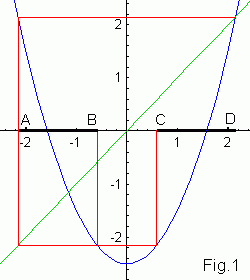

|
Cantor strange repellerYou see in Fig.1 that for c < -2 interval (BC) is mapped outside invariant interval Ic and all points go eventually to infinity. Two intervals [AB] and [BC] are mapped onto Ic. So similar to the tent map Cantor strange repeller with zero measure appears in quadratic maps (you see below such repeller for c = -3 on complex dynamical plane). |

|
In 1975 T.Y.Li and J.A.Yorke published the famous "Period three implies
chaos" paper. It turns out that nonlinear 1D map with period-3 orbit has
continuum of chaotic orbits. Let a,b,c make period-3 cycle
f(a) = b, f(b) = c, f(c) = a. It follows from the Fig.2 that inverse function f(x)-1 is multivalued in (b,c). When iterated f(x)-1 value gets in this interval we can chouse any branch at random and make chaotic orbits. |
Stable and unstable period-p cycles for quadratic map appear after tangent bifurcation of the fop(x) map. With decreasing c stable cycle loses its stability and two period-2p cycles appear. Unstable cycles never die. Therefore after period doubling cascade completion quadratic maps have infinite set of unstable periodic orbits.
[1] Mikhail Lyubich The Quadratic Family as a Qualitatively Solvable Model of Chaos Notices of the AMS, 47, 1042-1052 (2000)